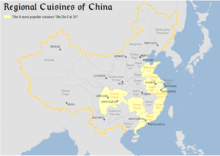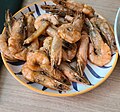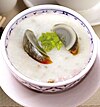
A | B | C | D | E | F | G | H | CH | I | J | K | L | M | N | O | P | Q | R | S | T | U | V | W | X | Y | Z | 0 | 1 | 2 | 3 | 4 | 5 | 6 | 7 | 8 | 9
This article needs additional citations for verification. (November 2019) |
| Cantonese cuisine | |||||||||||||||||||||||
|---|---|---|---|---|---|---|---|---|---|---|---|---|---|---|---|---|---|---|---|---|---|---|---|
 Chefs cook with a wok | |||||||||||||||||||||||
| Traditional Chinese | 廣東菜 | ||||||||||||||||||||||
| Simplified Chinese | 广东菜 | ||||||||||||||||||||||
| Jyutping | Gwong2 dung1 coi3 | ||||||||||||||||||||||
| Cantonese Yale | Gwóng dūng choi | ||||||||||||||||||||||
| |||||||||||||||||||||||
| Yue cuisine | |||||||||||||||||||||||
| Traditional Chinese | 粵菜 | ||||||||||||||||||||||
| Simplified Chinese | 粤菜 | ||||||||||||||||||||||
| Jyutping | Jyut6 coi3 | ||||||||||||||||||||||
| Cantonese Yale | Yuht choi | ||||||||||||||||||||||
| |||||||||||||||||||||||

Cantonese or Guangdong cuisine, also known as Yue cuisine (Chinese: 廣東菜 or 粵菜), is the cuisine of Guangdong province of China, particularly the provincial capital Guangzhou, and the surrounding regions in the Pearl River Delta including Hong Kong and Macau.[1] Strictly speaking, Cantonese cuisine is the cuisine of Guangzhou or of Cantonese speakers, but it often includes the cooking styles of all the speakers of Yue Chinese languages in Guangdong.
The Teochew cuisine and Hakka cuisine of Guangdong are considered their own styles. However, scholars may categorize Guangdong cuisine into three major groups based on the region's dialect: Cantonese, Hakka and Chaozhou cuisines.[2] Neighboring Guangxi's cuisine is also considered separate despite eastern Guangxi being considered culturally Cantonese due to the presence of ethnic Zhuang influences in the rest of the province.
Cantonese cuisine is one of the Eight Great Traditions of Chinese cuisine. Its prominence outside China is due to the large number of Cantonese emigrants. Chefs trained in Cantonese cuisine are highly sought after throughout China.[3] Until the late 20th century, most Chinese restaurants in the West served largely Cantonese dishes.
Background
| Part of a series on |
| Chinese cuisine |
|---|
 |
Guangzhou (Canton) City, the provincial capital of Guangdong and the centre of Cantonese culture, has long been a trading hub and many imported foods and ingredients are used in Cantonese cuisine. Besides pork, beef and chicken, Cantonese cuisine incorporates almost all edible meats, including offal, chicken feet, duck's tongue, frog legs, snakes and snails.[citation needed] However, lamb and goat are less commonly used than in the cuisines of northern or western China. Many cooking methods are used, with steaming and stir-frying being the most favoured due to their convenience and rapidity. Other techniques include shallow frying, double steaming, braising and deep frying.
Compared to other Chinese regional cuisines, the flavours of most traditional Cantonese dishes should be well-balanced and not greasy. Apart from that, spices should be used in modest amounts to avoid overwhelming the flavours of the primary ingredients, and these ingredients in turn should be at the peak of their freshness and quality.[4] There is no widespread use of fresh herbs in Cantonese cooking, in contrast with their liberal use in other cuisines such as Sichuanese, Vietnamese, Lao, Thai and European. Garlic chives and coriander leaves are notable exceptions, although the former are often used as a vegetable and the latter are usually used as mere garnish in most dishes.
Foods
Sauces and condiments
In Cantonese cuisine, ingredients such as sugar, salt, soy sauce, rice wine, corn starch, vinegar, scallion and sesame oil suffice to enhance flavour, although garlic is heavily used in some dishes, especially those in which internal organs, such as entrails, may emit unpleasant odours. Ginger, chili peppers, five-spice powder, powdered black pepper, star anise and a few other spices are also used, but often sparingly.
| English | Traditional Chinese | Simplified Chinese | Jyutping | Pinyin |
|---|---|---|---|---|
| Black bean sauce | 蒜蓉豆豉醬 | 蒜蓉豆豉酱 | syun3 jung4 dau6 si6 zoeng3 | suànróng dòuchǐjiàng |
| Char siu sauce | 叉燒醬 | 叉烧酱 | caa1 siu1 zoeng3 | chāshāojiàng |
| Chu hau paste | 柱侯醬 | 柱侯酱 | cyu5 hau4 zoeng3 | zhùhóujiàng |
| Hoisin sauce | 海鮮醬 | 海鲜酱 | hoi2 sin1 zoeng3 | hǎixiānjiàng |
| Master stock | 滷水 | 卤水 | lou5 seoi2 | lǔshuǐ |
| Oyster sauce | 蠔油 | 蚝油 | hou4 jau4 | háoyóu |
| Plum sauce | 蘇梅醬 | 苏梅酱 | syun1 mui4 zoeng3 | sūméijiàng |
| Red vinegar | 大紅浙醋 | 大红浙醋 | daai6 hung4 zit3 cou3 | dàhóngzhècù |
| Shrimp paste | 鹹蝦醬 | 咸虾酱 | haam4 haa1 zoeng3 | xiánxiājiàng |
| Sweet and sour sauce | 糖醋醬 | 糖醋酱 | tong4 cou3 zoeng3 | tángcùjiàng |
-
Oysters steamed in two ways: with ginger and garlic, and in black bean sauce
Dried and preserved ingredients
Although Cantonese cooks pay much attention to the freshness of their primary ingredients, Cantonese cuisine also uses a long list of preserved food items to add flavour to a dish. This may be influenced by Hakka cuisine, since the Hakkas were once a dominant group occupying imperial Hong Kong and other southern territories.
Some items gain very intense flavours during the drying/preservation/oxidation process and some foods are preserved to increase their shelf life. Some chefs combine both dried and fresh varieties of the same items in a dish. Dried items are usually soaked in water to rehydrate before cooking. These ingredients are generally not served a la carte, but rather with vegetables or other Cantonese dishes.
| Image | English | Traditional Chinese | Simplified Chinese | Jyutping | Pinyin | Notes |
|---|---|---|---|---|---|---|
 |
Century egg | 皮蛋 | pei4 daan2 | pídàn | Can be found served with roasted dishes, in congee with lean pork, and in a sweet pastry with lotus paste. | |
 |
Chinese sausage | 臘腸 | 腊肠 | laap6 coeng2 | làcháng | Usually added to rice together with preserved-salted duck and pork. |
 |
Dried cabbage | 菜乾 | 菜干 | coi3 gon1 | càigān | |
 |
Dried scallops | 江珧柱 | gong1 jiu4 cyu5 | jiāngyáozhù | Usually added to clear soup. | |
| 江瑤柱 | 江瑶柱 | |||||
 |
Dried shrimp | 蝦乾 | 虾干 | haa1 gon1 | xiāgān | Usually de-shelled, sliced into half and added to vegetable dishes. |
 |
Dried small shrimp | 蝦米 | 虾米 | haa1 mai5 | xiāmǐ | Usually mixed with stir-fried vegetables. |
 |
Fermented tofu | 腐乳 | fu6 jyu5 | fǔrǔ | ||
 |
Fermented black beans | 豆豉 | dau6 si6 | dòuchǐ | Usually added to pork and tofu dishes. | |
 |
Pickled Chinese cabbage | 梅菜 | mui4 coi3 | méicài | Usually cooked with pork or stir-fried with rice. | |
 |
Pickled diced radish | 菜脯 | coi3 pou2 | càifǔ | ||
 |
Preserved-salted duck | 臘鴨 | 腊鸭 | laap6 aap2 | làyā | Usually eaten with rice in a family meal. |
 |
Preserved-salted pork | 臘肉 | 腊肉 | laap6 juk6 | làròu | Usually eaten with rice in a family meal. |
 |
Salted duck egg | 鹹蛋 | 咸蛋 | haam4 daan2 | xiándàn | May be eaten as it is or mixed with stir-fried vegetables and steam dishes or cooked with diced pork in congee. |
 |
Salted fish | 鹹魚 | 咸鱼 | haam4 jyu2 | xiányú | Usually paired with steamed pork or added to fried rice together with diced chicken. |
 |
Suan cai | 鹹酸菜 | 咸酸菜 | haam4 syun1 coi3 | xiánsuāncài | |
 |
Tofu skin | 腐皮 | fu6 pei4 | fǔpí | Usually used as wrapping for ground pork dishes. It is fried in a similar manner as spring rolls. | |
Traditional dishes
A number of dishes have been part of Cantonese cuisine since the earliest territorial establishments of Guangdong. While many of these are on the menus of typical Cantonese restaurants, some simpler ones are more commonly found in Cantonese homes. Home-made Cantonese dishes are usually served with plain white rice.
| Name | Image | Traditional Chinese | Simplified Chinese | Jyutping | Pinyin |
|---|---|---|---|---|---|
| Cantonese style fried rice |  |
廣式炒飯 | 广式炒饭 | gwong2 sik1 cau2 faan6 | guǎng shì chǎofàn |
| Choy sum in oyster sauce |  |
蠔油菜心 | 蚝油菜心 | hou4 jau4 coi3 sam1 | háoyóu càixīn |
| Congee with lean pork and century egg |  |
皮蛋瘦肉粥 | pei4 daan2 sau3 juk6 zuk1 | pídàn shòuròuzhōu | |
| Steamed egg |  |
蒸水蛋 | zing1 seoi2 daan2 | zhēngshuǐdàn | |
| Steamed frog legs on lotus leaf | 荷葉蒸田雞 | 荷叶蒸田鸡 | ho4 jip6 zing1 tin4 gai1 | héyè zhēng tiánjī | |
| Steamed ground pork with salted duck egg |  |
鹹蛋蒸肉餅 | 咸蛋蒸肉饼 | haam4 daan2 zing1 juk6 beng2 | xiándàn zhēng ròubǐng |
| Steamed spare ribs with fermented black beans and chilli pepper |  |
豉椒排骨 | si6 ziu1 paai4 gwat1 | chǐjiāo páigǔ | |
| Stewed beef brisket |  |
柱侯牛腩 | cyu5 hau4 ngau4 naam5 | zhùhóu niú nǎn | |
| Stir-fried hairy gourd with dried shrimp and cellophane noodles | 大姨媽嫁女 | 大姨妈嫁女 | daai6 ji4 maa1 gaa3 neoi5 | dàyímā jiànǚ | |
| Stir-fried water spinach with shredded chilli and fermented tofu |  |
椒絲腐乳通菜 | 椒丝腐乳通菜 | ziu1 si1 fu6 jyu5 tung1 coi3 | jiāosī fǔrǔ tōngcài |
| Sweet and sour pork |  |
咕嚕肉 | 咕噜肉 | gu1 lou1 juk6 | gūlūròu |
| Shunde-style fish slices[5] |  |
順德魚生 | 顺德鱼生 | seon6 dak1 jyu4 saang1 | shùndé yú shēng |
Deep fried dishes
There are a small number of deep-fried dishes in Cantonese cuisine, which can often be found as street food. They have been extensively documented in colonial Hong Kong records of the 19th and 20th centuries. A few are synonymous with Cantonese breakfast and lunch,[6] even though these are also part of other cuisines.
| English | Image | Traditional Chinese | Simplified Chinese | Jyutping | Pinyin |
|---|---|---|---|---|---|
| Dace fish balls |  |
鯪魚球 | 鲮鱼球 | leng4 jyu4 kau4 | língyúqiú |
| Chinese Donut |  |
油炸鬼 | jau4 zaa3 gwai2 | yóuzháguǐ | |
| Zaa Leung |  |
炸兩 | 炸两 | zaa3 loeng5 | zháliǎng |
Soups
Old fire soup, or lou fo tong (老火汤; 老火湯; lǎohuǒ tāng; lou5 fo2 tong; 'old fire-cooked soup'), is a clear broth prepared by simmering meat and other ingredients over a low heat for several hours. Chinese herbs are often used as ingredients. There are basically two ways to make old fire soup – put ingredients and water in the pot and heat it directly on fire, which is called bou tong (煲汤; 煲湯; bāo tāng; bou1 tong1); or put the ingredients in a small stew pot, and put it in a bigger pot filled with water, then heat the bigger pot on fire directly, which is called dun tong (燉汤; 燉湯; dùn tāng; dan6 tong1). The latter way can keep the most original taste of the soup.
Soup chain stores or delivery outlets in cities with significant Cantonese populations, such as Hong Kong, serve this dish due to the long preparation time required of slow-simmered soup.
| English | Traditional Chinese | Simplified Chinese | Jyutping | Pinyin |
|---|---|---|---|---|
| Cantonese seafood soup | 海皇羹 | hoi2 wong4 gang1 | hǎihuáng gēng | |
| Night-blooming cereus soup | 霸王花煲湯 | 霸王花煲汤 | baa3 wong4 faa1 bou1 tong1 | bàwánghuā bāotāng |
| Snow fungus soup | 銀耳湯 | 银耳汤 | ngan4 ji5 tong1 | yín'ěr tāng |
| Spare ribs soup with watercress and apricot kernels | 南北杏西洋菜豬骨湯 | 南北杏西洋菜猪骨汤 | naam4 bak1 hang6 sai1 joeng4 coi3 zyu1 gwat1 tong1 | nánběixìng xīyángcài zhūgǔ tāng |
| Winter melon soup | 冬瓜湯 | 冬瓜汤 | dung1 gwaa1 tong1 | dōngguā tāng |
Seafood

Due to Guangdong's location along the South China Sea coast, fresh seafood is prominent in Cantonese cuisine, and many Cantonese restaurants keep aquariums or seafood tanks on the premises. In Cantonese cuisine, as in cuisines from other parts of Asia, if seafood has a repugnant odour, strong spices and marinating juices are added; the freshest seafood is odourless and, in Cantonese culinary arts, is best cooked by steaming. For instance, in some recipes, only a small amount of soy sauce, ginger and spring onion is added to steamed fish. In Cantonese cuisine, the light seasoning is used only to bring out the natural sweetness of the seafood. As a rule of thumb, the spiciness of a dish is usually negatively correlated to the freshness of the ingredients.
| Image | English | Traditional Chinese | Simplified Chinese | Jyutping | Pinyin |
|---|---|---|---|---|---|
 |
Lobster with ginger and scallions | 薑蔥龍蝦 | 薑葱龙虾 | goeng1 cung1 lung4 haa1 | jiāngcōng lóngxiā |
 |
Mantis shrimp | 攋尿蝦 | 濑尿虾 | laai6 niu6 haa1 | làniàoxiā |
 |
Steamed fish | 蒸魚 | 蒸鱼 | zing1 yu4 | zhēngyú |
 |
Steamed scallops with ginger and garlic | 蒜茸蒸扇貝 | 蒜茸蒸扇贝 | syun3 jung4 zing1 sin3 bui3 | suànróng zhēng shànbèi |
 |
White boiled shrimp | 白灼蝦 | 白灼虾 | baak6 zoek3 haa1 | báizhuóxiā |
-
Zdroj:https://en.wikipedia.org?pojem=Cantonese_cuisine
Text je dostupný za podmienok Creative Commons Attribution/Share-Alike License 3.0 Unported; prípadne za ďalších podmienok. Podrobnejšie informácie nájdete na stránke Podmienky použitia.
Antropológia
Aplikované vedy
Bibliometria
Dejiny vedy
Encyklopédie
Filozofia vedy
Forenzné vedy
Humanitné vedy
Knižničná veda
Kryogenika
Kryptológia
Kulturológia
Literárna veda
Medzidisciplinárne oblasti
Metódy kvantitatívnej analýzy
Metavedy
Metodika
Text je dostupný za podmienok Creative
Commons Attribution/Share-Alike License 3.0 Unported; prípadne za ďalších
podmienok.
Podrobnejšie informácie nájdete na stránke Podmienky
použitia.
www.astronomia.sk | www.biologia.sk | www.botanika.sk | www.dejiny.sk | www.economy.sk | www.elektrotechnika.sk | www.estetika.sk | www.farmakologia.sk | www.filozofia.sk | Fyzika | www.futurologia.sk | www.genetika.sk | www.chemia.sk | www.lingvistika.sk | www.politologia.sk | www.psychologia.sk | www.sexuologia.sk | www.sociologia.sk | www.veda.sk I www.zoologia.sk



